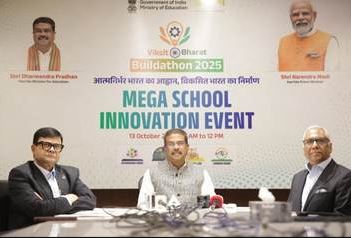“Scientists have discovered a simple yet effective way to detect toxic molecules at extremely low concentrations—using the same process that creates coffee stains”
New Delhi 14/10/2025 Report By Santosh Seth
When a drop of coffee evaporates on a tabletop, it forms a distinctive dark ring around the edge. This everyday phenomenon, or coffee-stain effect, is due to the fact that as the liquid dries, particles suspended in the liquid move outward and collect at the edge.
Researchers have known for some time that this principle holds true not only for coffee, but also for droplets of other particles.
By investigating and manipulating this natural phenomenon, scientists can induce nanoparticles to align in specific, highly ordered patterns at the edges of dried stains.
These ring-shaped deposits can be used as miniature scenarios where light interacts with matter. This creates unique opportunities to detect quantities of certain substances that would otherwise be too small to measure.
Researchers at the Raman Research Institute (RRI), an autonomous institute supported by the Department of Science and Technology (DST), Government of India, focused on Rhodamine B, a fluorescent synthetic dye used in textiles and cosmetics. However, this dye is toxic and causes irritation to the skin, eyes, and even the respiratory tract. It is also a significant environmental pollutant because it persists in water.
The team exploited the coffee-staining effect with gold nanorods, microscopic rods a few tens of nanometers long. They deposited a drop of water containing these rods on a clean, water-repellent silicon surface and allowed the water to evaporate.
As the drop evaporated, the rods reached its edge and remained there in a ring. Depending on the concentration of rods in the droplet, the edge deposition can be either a thin, loosely spread layer or a dense, tall structure in which the rods are packed end-to-end and side-to-side.
These dense edge structures are particularly important because they create hundreds of “hot spots” where light is extremely intense.
When a laser is directed at the spot, the rhodamine B molecules attached to the gold rods in these areas produce a much brighter optical signal than they would produce individually.
At low concentrations of gold nanorods, only relatively high amounts of rhodamine B could be detected—approximately equivalent to a drop of dye in a glass of water.
As the nanorod concentration increased, the detection limit improved rapidly. With the densest ring deposition, the system could detect rhodamine B down to one part in a trillion.
Remarkably, a hundredfold increase in nanorod concentration translated into a nearly million-fold increase in sensitivity.
“Dye molecules like rhodamine B have been banned in products such as food and cosmetics due to their toxicity, but regulators face challenges in monitoring their illegal use, including the low concentrations used in products and the lack of availability of detection equipment,” said RRI researcher A.W. Zabudeen.
Yathindran K., an engineer in soft condensed matter, explained. “Once these dyes enter food or water bodies, they can be diluted to concentrations as low as parts per trillion, making them difficult to detect using conventional characterization techniques.
Therefore, a more sensitive detection method, such as surface-enhanced Raman spectroscopy (SERS), may be required,” said M.
Practically, the scientists demonstrated that it is possible to use a simple, naturally occurring pattern, which arises from the same phenomenon that causes coffee rings on a table, into an extremely powerful and inexpensive technique for chemical detection.
“This technique is simple and cost-effective. After the liquid drop evaporates, the dried pattern concentrates the nanoparticles, and the resulting hotspots allow us to detect even picomolar quantities of toxins.
Even hand-held Raman spectrometers can potentially be used to detect toxins using this technique,” said Ranjini Bandyopadhyay, Professor of Soft Condensed Matter at RRI.
In general, this technology can be used for a wide range of harmful substances, and can be transformed into advanced technology to reduce disease and environmental damage.




